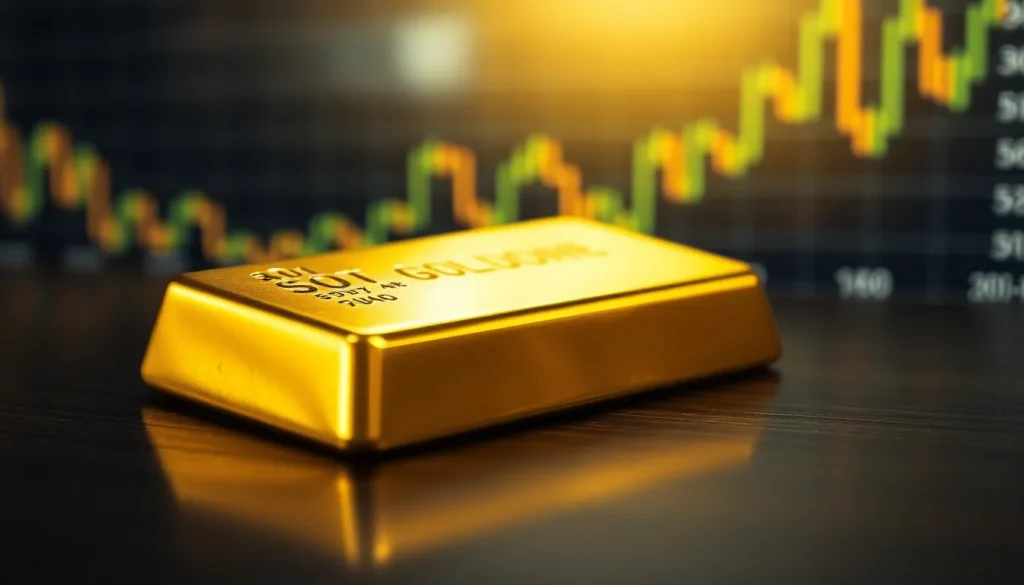Gold has long been a symbol of wealth and stability, making it a go-to investment for many. As the financial landscape shifts, knowing the spot price of gold today is crucial for investors and enthusiasts alike. This price reflects the current market value and can fluctuate throughout the day based on various economic factors.
Understanding the spot price not only helps in making informed decisions but also sheds light on broader market trends. Whether one is looking to buy, sell, or simply track gold’s performance, staying updated on its spot price is essential. In this article, we’ll explore what influences gold prices and provide the latest figures to keep readers well-informed.
Table of Contents
ToggleUnderstanding Spot Price
Spot price represents the current market price for immediate delivery of gold. Tracking this price allows investors to make informed decisions.
Definition of Spot Price
Spot price refers to the current price at which gold can be bought or sold for immediate delivery. It reflects real-time market dynamics and is typically quoted in U.S. dollars per ounce. Investors and traders monitor this price closely, as it serves as a benchmark for buying physical gold or gold-related financial products.
Factors Influencing Spot Price
- Supply and Demand: Increased demand for gold during times of economic uncertainty often drives prices higher.
- Geopolitical Events: Tensions or instability in regions significant for gold mining can affect supply and, subsequently, prices.
- Currency Strength: A stronger U.S. dollar often leads to lower gold prices, while a weaker dollar typically lifts them.
- Interest Rates: Higher interest rates can decrease gold’s appeal as an investment, leading to lower prices.
- Inflation Rates: Rising inflation often boosts gold’s attractiveness as a hedge, driving spot prices upward.
- Market Speculation: Trader sentiment and market speculation can create fluctuations in gold prices, impacting the spot price significantly.
Current Market Overview

The current market for gold fluctuates continuously, influenced by a variety of economic variables. Staying updated on the daily spot price is crucial for investors seeking to optimize their strategies.
Daily Spot Price Trends
Today’s spot price of gold stands at approximately $1,900 per ounce. Daily fluctuations often occur due to market reactions to economic data releases and geopolitical tensions. For instance, a recent increase in inflation may elevate investors’ interest in gold as a hedge. Price variations today suggest a trend of increasing demand amid global uncertainties, emphasizing the importance of monitoring these changes in real-time.
Historical Comparisons
When comparing today’s spot price to historical data, gold’s value reflects significant shifts. In comparison to last year’s price, which averaged around $1,800 per ounce, current prices show a growth of about 5.6%. Analyzing long-term trends, the price of gold has increased from approximately $1,400 per ounce five years ago, highlighting its resilience as a valuable asset during economic fluctuations. Historical price charts reveal patterns and help investors gauge future performance based on past movements.
Why Spot Price Matters
Spot price serves as a critical indicator for investors, reflecting the immediate market value of gold. Understanding this price aids in making informed investment decisions and responding to economic changes effectively.
Investment Decisions
Spot price influences investment decisions significantly. Investors analyze fluctuations to determine when to buy or sell gold. Tracking these changes enables them to capitalize on gains or mitigate potential losses. For example, a rise in spot price may encourage buying as it indicates growing demand. Conversely, a decline might prompt selling to avoid losses. Additionally, gold’s spot price serves as a benchmark for futures contracts and exchange-traded funds (ETFs), guiding investment strategies and portfolio management.
Economic Indicators
Spot price functions as a barometer for economic health. Economic indicators, such as inflation rates and currency values, directly impact gold prices. When inflation rises, gold often sees increased demand as a hedge against currency depreciation. Similarly, a weakening U.S. dollar typically correlates with higher gold prices, as it costs more in weaker currencies. Investors leverage this relationship to gauge market trends and adjust their portfolios accordingly. Regular monitoring of spot price in conjunction with these indicators not only highlights gold’s role as a financial safeguard but also offers insights into broader economic shifts.
How to Track Spot Price
Tracking the spot price of gold involves utilizing reliable sources and effective tools. Investors benefit from staying informed through various platforms that provide real-time data.
Reliable Sources
- Market Exchanges: Major exchanges like the COMEX and London Bullion Market Association (LBMA) provide official spot prices. Data from these exchanges reflects true market demands.
- Financial News Websites: Reputable financial websites such as Bloomberg and CNBC report spot prices and market trends. These sources aggregate information from multiple exchanges to offer comprehensive updates.
- Gold Price Apps: Mobile applications, such as Kitco and Gold Price Live, deliver instant notifications of spot price changes. Users can customize alerts for price fluctuations, ensuring timely updates.
- Investment Brokers: Many brokerage platforms provide clients with up-to-date spot prices as part of their services. These platforms often include additional market analysis and insights.
Tools for Monitoring
- Price Tracking Websites: Websites like Goldprice.org and Investing.com specialize in real-time monitoring of gold prices. These platforms also offer historical data, charts, and analysis.
- Mobile Applications: Apps such as Gold Live! and BullionVault allow users to access current prices while on the go. Features may include price charts and historical data analysis.
- Email Alerts: Subscribing to email alerts from financial news sites or precious metal brokers keeps investors informed about significant price changes. These alerts enable quick decision-making.
- Social Media: Following industry experts and financial analysts on platforms like Twitter and LinkedIn offers real-time insights and discussions regarding gold price movements.
By leveraging these reliable sources and tools, investors gain a comprehensive understanding of the spot price of gold, allowing for informed investment decisions.
Staying updated on the spot price of gold is crucial for anyone interested in this precious metal. Today’s price of around $1,900 per ounce reflects ongoing economic trends and investor sentiment. As demand rises amid inflation and geopolitical uncertainties, understanding these dynamics can help investors make better decisions.
By regularly tracking the spot price through reliable sources and tools, individuals can gain valuable insights into market movements. This knowledge not only aids in timing investments but also enhances one’s overall strategy in navigating the complexities of gold as an asset.






